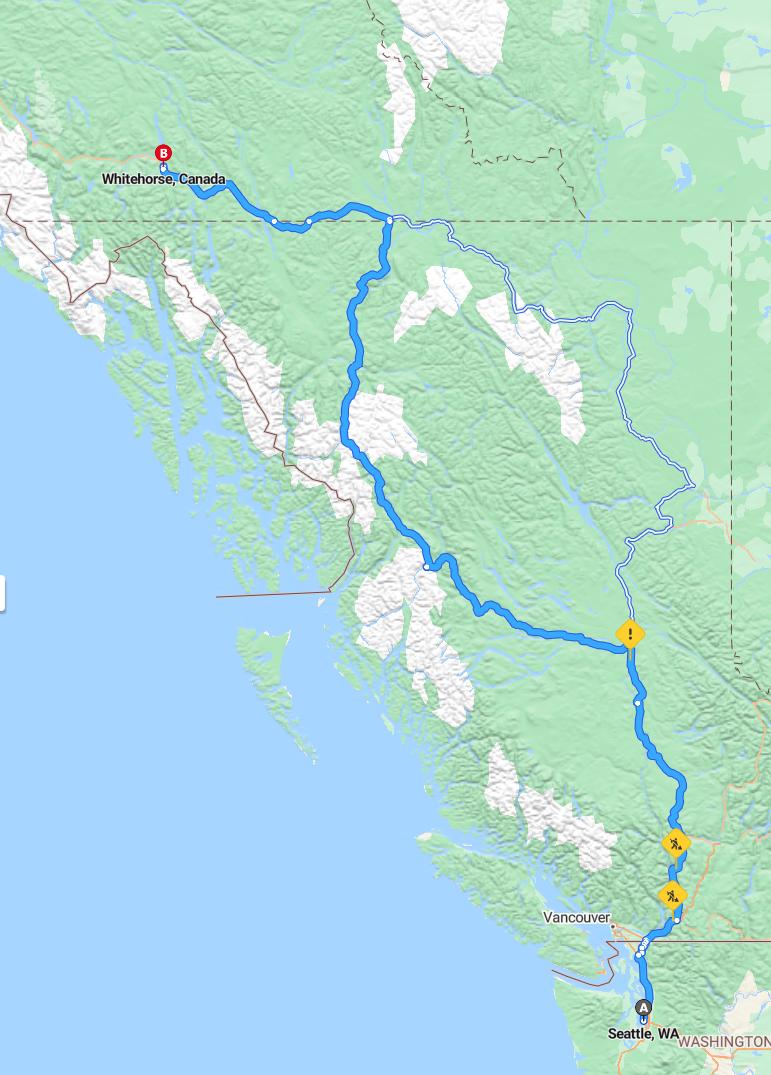Distance and estimated driving time
Embarking on a road trip from Seattle to Whitehorse offers an adventurous journey covering approximately 1,560 miles over an estimated duration of 26 hours and 50 minutes. The most efficient route takes you along highways TC-16 W and BC-37, providing scenic views and access to various national parks and natural attractions. Planning ahead for rest breaks and overnight stays can help ensure a safe and enjoyable trip through the stunning wilderness of the Pacific Northwest and Canadian Yukon. This route is ideal for travelers seeking to explore diverse landscapes while experiencing the thrill of cross-border exploration.
Driving route
Traveling from Seattle to Whitehorse offers a scenic journey through diverse landscapes, starting in the vibrant city of Seattle. Continuing northwest, you'll pass through Vancouver, a bustling Canadian city known for its stunning waterfront and multicultural atmosphere. The route then leads north through British Columbia's rugged terrain before entering the Yukon, culminating in Whitehorse, the capital of Yukon with its rich history and natural beauty. The drive provides an opportunity to experience the changing scenery from urban landscapes to pristine wilderness. Proper planning is essential to ensure safe travel across borders and through remote areas, especially considering the vast distances involved.

Best time of year to undertake the trip
The best time to undertake a road trip from Seattle to Whitehorse is during the late spring to early fall months, roughly from May to September, when the weather is generally mild and roads are typically clear of snow. Traveling in summer provides longer daylight hours and better road conditions, making the journey more comfortable and safer. Visiting during this period also allows travelers to enjoy the stunning natural scenery and outdoor activities along the route, including Vancouver and Whitehorse. Conversely, early spring and late fall can bring unpredictable weather and potential road closures, so planning for the summer months ensures a smoother and more enjoyable adventure.
Necessary travel documents and permits
Traveling from Seattle to Whitehorse requires travelers to have valid identification and appropriate permits for crossing international borders. U.S. and Canadian citizens should carry valid passports or other accepted travel documents, such as Nexus cards, to facilitate smooth border crossings. Additionally, travelers should ensure they have any necessary vehicle permits or registrations, especially when transporting goods or commercial vehicles. It is advisable to verify current entry requirements and restrictions with official border and customs authorities prior to departure to avoid any travel disruptions.
Vehicle requirements and safety tips
When planning a road trip from Seattle to Whitehorse through Vancouver, it's essential to ensure your vehicle meets regional requirements and safety standards. Make sure your vehicle is properly maintained with up-to-date fluid levels, tire pressure, and functioning brakes, especially since mountainous and remote areas demand reliable performance. Carry necessary safety equipment such as a first aid kit, spare tire, jumper cables, and extra food and water, as services may be limited in remote stretches. Additionally, familiarize yourself with local driving laws and weather conditions to respond appropriately to changing environments and ensure a safe, smooth journey.
Points of interest along the route
The drive from Seattle to Whitehorse offers travelers a variety of fascinating points of interest. In Vancouver, visitors can explore Stanley Park, Granville Island, and the vibrant waterfront, offering stunning cityscapes and cultural experiences. Continuing north, travelers pass through scenic landscapes featuring lush forests, mountain ranges, and pristine lakes. Upon reaching Whitehorse, highlights include the historic Yukon River, the bustling downtown area, and outdoor activities such as hiking and visiting the nearby Kluane National Park, making the journey both scenic and culturally enriching.
Accommodation options en route
Travelers driving from Seattle to Whitehorse have a variety of accommodation options along the route, including hotels, motels, and cozy lodges. In Vancouver, visitors can choose from luxury hotels, boutique inns, and budget-friendly motels to suit their preferences. As you continue north, Whitehorse offers several charming inns, rustic cabins, and modern hotels to ensure a comfortable stay upon arrival. It is advisable to book accommodations in advance, especially during peak travel seasons, to secure the best rates and availability.
Weather conditions and seasonal considerations
Traveling from Seattle to Whitehorse involves passing through a variety of climate zones, which significantly influence weather conditions and seasonal considerations. In the summer months, travelers can expect milder temperatures and longer daylight hours, making the journey more comfortable and accessible. Conversely, winter travel poses challenges such as snow, ice, and colder temperatures, especially as you approach Whitehorse, where winter storms are common. Preparing for varying weather conditions by checking current forecasts and carrying appropriate gear is essential for a safe and smooth trip across this diverse northern route.
Fuel stations and availability
Traveling from Seattle to Whitehorse, drivers can find fuel stations conveniently along major cities such as Vancouver and Whitehorse. In Vancouver, numerous fuel stations provide ample options for refueling, ensuring a smooth continuation of the journey. As travelers head north into more remote regions, fuel availability may become less frequent, so it is advisable to plan stops accordingly. Once in Whitehorse, fuel stations are readily accessible, making it easy to top off before concluding the trip or exploring the surrounding areas.
Local regulations and driving laws
When driving from Seattle to Whitehorse, travelers should be aware of different local regulations and driving laws along the route. In Washington and British Columbia, strict speed limits and seat belt laws are enforced, with penalties for violations. As you cross into Yukon, specific regulations such as curfews for commercial vehicles and wildlife caution signs are prominent, requiring drivers to stay alert. Familiarizing yourself with each region's traffic rules ensures a safe journey through diverse jurisdictions.
